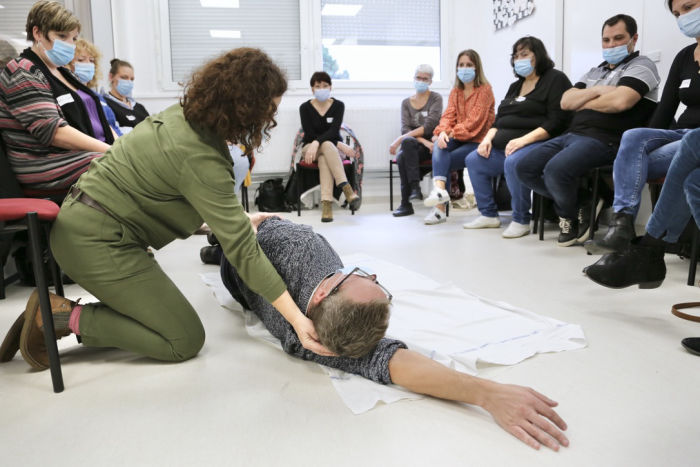
AFGSU2Certificate of Training in Emergency First Aid
(level 2)
(level 2)
TARGET PUBLIC
Professionals practicing one of the health professions listed in Part 4 of the Public Health Code, and students enrolled at a university or training school or institute preparing for obtainment of a degree in order to practice one of these health professions. The certificate is also open to individuals holding State Diplomas in Medico-Psychological Support.
GENERAL AND EDUCATIONAL OBJECTIVES
Objectives, module 1: vital emergencies
This module enables learners to:
• Identify an immediate danger and provide appropriate protection, on a daily basis
• Alert the SAMU or the institution’s in-house number, communicate information and follow the advice provided
• Identify unconsciousness and ensure that the airways of a spontaneously breathing unconscious individual are unobstructed and protected
• Identify an acute airway obstruction and take appropriate action
• Stop external bleeding
• Identify a heart attack and carry out cardiopulmonary resuscitation or have it carried out, with the emergency equipment provided (automated external defibrillator, crash cart, onboard equipment, etc.)
• Implement non-invasive devices for monitoring vital signs
• Apply emergency device maintenance and materiovigilance procedures
Objectives, module 2: potential emergencies
This module enables learners to:
• Identify signs of the seriousness of an ailment and of a bone or skin trauma and take appropriate action
• Identify signs of a burn’s seriousness and act accordingly
• Apply elementary rules of hygiene
• When there is no doctor nearby, ask SAMU for advice and communicate observations in compliance with ethical and professional rules
• Take suitable measures for treatment of a trauma (immobilisation equipment, removal of a motorbike helmet if necessary)
• Lift and stretcher a patient or have them lifted and stretchered
• Take appropriate measures for mother and child during a sudden delivery
• Apply protective rules in the face of risk of infection
Objectives, module 3: collective risks
This module enables learners to:
• Identify a danger and apply appropriate protection instructions
• Participate in implementation of organisation of the healthcare response system in exceptional health situations (ORSAN Plan)
• Take part in implementation of contingency plans, and the White Plan or Blue Plan, depending on the role provided for their profession
• Become aware of NRBCE (nuclear, radiological, biological, chemical and explosive) risks and identify their role in the event of activation of special provisions relating to such risks, and the various personal protective devices.
ORGANISATION
21 hours divided into 3 consecutive 7-hour days
Time: 9 a.m. – 5 p.m.
Group size
Groups of 10 to 12 learners per facilitator
Cost
€350 per learner
Next sessions
Scheduling underway, feel free to contact us.
(Possibility of sessions on request)

